Cypress is a common name for various coniferous trees or shrubs of northern temperate regions that belong to the family Cupressaceae. The word cypress is derived from Old French cipres, which was imported from Latin cypressus, the latinisation of the Greek κυπάρισσος (kyparissos). Cypress trees are a large classification of conifers, encompassing the trees and shrubs from the cypress family (Cupressaceae) and many others with the word “cypress” in their common name. Many cypress trees have needle-like, evergreen foliage and acorn-like seed cones.
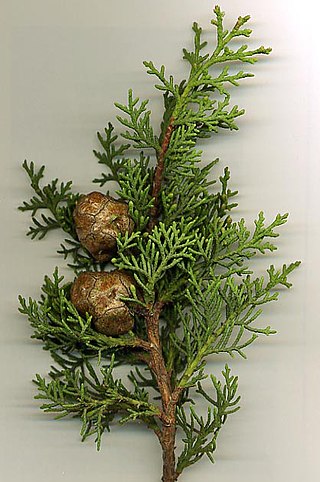
Cupressaceae is a conifer family, the cypress family, with worldwide distribution. The family includes 27–30 genera, which include the junipers and redwoods, with about 130–140 species in total. They are monoecious, subdioecious or (rarely) dioecious trees and shrubs up to 116 m (381 ft) tall. The bark of mature trees is commonly orange- to red- brown and of stringy texture, often flaking or peeling in vertical strips, but smooth, scaly or hard and square-cracked in some species.
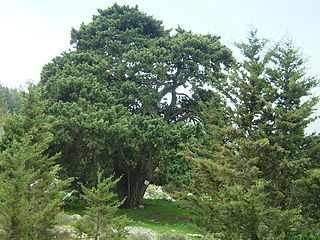
Cupressus is one of several genera of evergreen conifers within the family Cupressaceae that have the common name cypress; for the others, see cypress. It is considered a polyphyletic group. Based on genetic and morphological analysis, the genus Cupressus is found in the subfamily Cupressoideae. The common name "cypress" comes via the Old French cipres from the Latin cyparissus, which is the latinisation of the Greek κυπάρισσος (kypárissos).
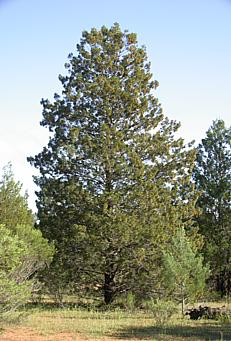
Callitris is a genus of coniferous trees in the Cupressaceae. There are 16 recognized species in the genus, of which 13 are native to Australia and the other three native to New Caledonia. Traditionally, the most widely used common name is cypress-pine, a name shared by some species of the closely related genus Actinostrobus.
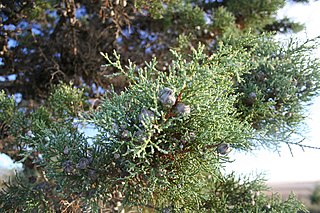
Actinostrobus is a genus of coniferous trees in the Cupressaceae. Common names include cypress, sandplain-cypress and cypress-pine, the last of these shared by the closely related genus Callitris.
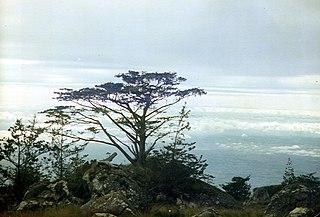
Widdringtonia is a genus of coniferous trees in the Cupressaceae. The name was Austrian botanist Stephan Endlicher's way of honouring an early expert on the coniferous forests of Spain, Capt. Samuel Edward Widdrington (1787–1856). There are four species, all native to southern Africa, where they are known as cedars or African cypresses.

Austrocedrus is a genus of conifer belonging to the cypress family (Cupressaceae). It has only one species, Austrocedrus chilensis, native to the Valdivian temperate rain forests and the adjacent drier steppe-forests of central-southern Chile and western Argentina from 33°S to 44°S latitude. It is known in its native area as ciprés de la cordillera or cordilleran cypress, and elsewhere by the scientific name as Austrocedrus, or sometimes as Chilean incense-cedar or Chilean cedar. The generic name means "southern cedar".

Diselma archeri is a species of plant of the family Cupressaceae and the sole species in the genus Diselma. It is endemic to the alpine regions of Tasmania's southwest and Central Highlands, on the western coast ranges and Lake St. Clair. It is a monotypic genus restricted to high altitude rainforest and moist alpine heathland. Its distribution mirrors very closely that of other endemic Tasmanian conifers Microcachrys tetragona and Pherosphaera hookeriana.

Callitris pancheri is a plant species of the family Cupressaceae. It is endemic to New Caledonia, where it occurs in small, scattered population along rivers. It used to be placed in its own genus Neocallitropsis but molecular phylogenetic analysis indicated that it was nested within Callitris.

Actinostrobus pyramidalis, commonly known as swamp cypress, Swan River cypress and King George's cypress pine, is a species of coniferous tree in the Cupressaceae. Like the other species in the genus Actinostrobus, it is endemic to southwestern Western Australia.
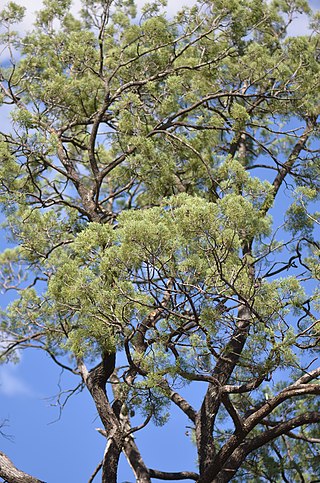
Callitris columellaris is a species of coniferous tree in the family Cupressaceae, native to most of Australia. Common names include white cypress, white cypress-pine, Murray River cypress-pine, and northern cypress-pine. Callitris columellaris has become naturalised in Hawaii and in southern Florida.
Actinostrobus acuminatus, commonly known as dwarf cypress, creeping pine or Moore cypress pine, is a species of coniferous tree in the Cupressaceae. Like the other species in the genus Actinostrobus, it is endemic to southwestern Western Australia, where it can be found along the shorelines of rivers. The Mount Henry Peninsula is an example of the environment in which this cypress is found. It shares the common name dwarf cypress with several other plants, and shares the name creeping pine with others.
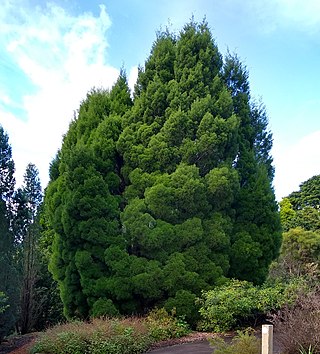
Callitris baileyi is a species of conifer in the family Cupressaceae. It is found only in Australia, more specifically Southeast Queensland. Its common English name is Bailey's cypress-pine. The name is dedicated to Australian botanist Frederick Manson Bailey, who was the first to collect specimens of this tree. Bailey's name is closely associated with much of the flora of Queensland and their elucidation in Southeastern Queensland. Over the past few decades the conifer has been severely threatened by habitat loss Fruiting for the species has been recorded year-round.

Callitris endlicheri, commonly known as the black cypress pine, is a species of conifer in the family Cupressaceae. It is found only in Australia, occurring inQueensland, New South Wales, the Australian Capital Territory, and Victoria.

Callitris macleayana is a species of conifer in the family Cupressaceae, endemic to Australia. The tree is commonly known as stringybark pine, as well as brush cypress pine and Port Macquarie pine, although it does not belong to the pine genus or family. Stringybark pine is found in two regions of Australia's East coast, one in the centre and one in the North.

Callitris monticola, commonly known as the steelhead or dwarf cypress, is a species of conifer in the family Cupressaceae. It is found only in Australia, occurring in the states of Queensland and New South Wales and is considered vulnerable due to its restricted distribution.

Callitris oblonga, also known as the South Esk pine, pigmy cypress pine, pigmy cypress pine, river pine, or Tasmanian cypress pine, is a species of conifer in the family Cupressaceae. It is endemic to Australia, where it is native to New South Wales and Tasmania, with one subspecies introduced in Victoria. It is considered vulnerable and faces a number of threats including land clearing, habitat degradation, and damage from or competition with invasive species.

Callitris preissii is a species of conifer in the family Cupressaceae, endemic to Rottnest Island, Australia. Common names include Rottnest Island pine, Murray pine, maroong, southern cypress pine, or slender cypress pine. The Noongar peoples know the tree as marro.
Callitris roei, or Roe's cypress-pine, is a species of Callitris native to Australia, where it is endemic to southwestern Western Australia from Moora south to Albany and east to Cape Arid National Park.

Callitris verrucosa, also known as the Mallee Pine, is a species of conifer in the family Cupressaceae. It is found only in Australia. The tree/shrub has a green/grey colour, rigid branches and can reach a height of 8m. The tree/shrub has a slow grow rate.


















